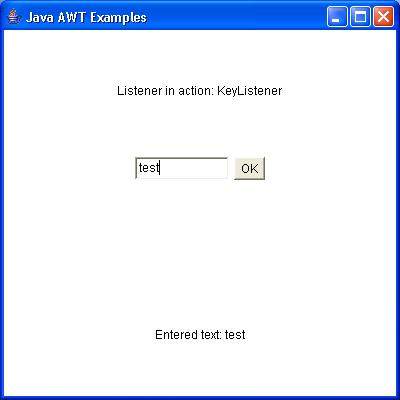
- AWT - Home
- AWT - Overview
- AWT - Environment
- AWT - Controls
- AWT - Event Handling
- AWT - Event Classes
- AWT - Event Listeners
- AWT - Event Adapters
- AWT - Layouts
- AWT - Containers
- AWT - Menu
- AWT - Graphics
AWT - Useful Resources
AWT KeyListener Interface
The class which processes the KeyEvent should implement this interface.The object of that class must be registered with a component. The object can be registered using the addKeyListener() method.
Interface declaration
Following is the declaration for java.awt.event.KeyListener interface:
public interface KeyListener extends EventListener
Interface methods
| S.N. | Method & Description |
|---|---|
| 1 |
void keyPressed(KeyEvent e) Invoked when a key has been pressed. |
| 2 |
void keyReleased(KeyEvent e) Invoked when a key has been released. |
| 3 |
void keyTyped(KeyEvent e) Invoked when a key has been typed. |
Methods inherited
This interface inherits methods from the following interfaces:
java.awt.EventListener
KeyListener Example
Create the following java program using any editor of your choice in say D:/ > AWT > com > tutorialspoint > gui >
AwtListenerDemo.java
package com.tutorialspoint.gui;
import java.awt.*;
import java.awt.event.*;
public class AwtListenerDemo {
private Frame mainFrame;
private Label headerLabel;
private Label statusLabel;
private Panel controlPanel;
private TextField textField;
public AwtListenerDemo(){
prepareGUI();
}
public static void main(String[] args){
AwtListenerDemo awtListenerDemo = new AwtListenerDemo();
awtListenerDemo.showKeyListenerDemo();
}
private void prepareGUI(){
mainFrame = new Frame("Java AWT Examples");
mainFrame.setSize(400,400);
mainFrame.setLayout(new GridLayout(3, 1));
mainFrame.addWindowListener(new WindowAdapter() {
public void windowClosing(WindowEvent windowEvent){
System.exit(0);
}
});
headerLabel = new Label();
headerLabel.setAlignment(Label.CENTER);
statusLabel = new Label();
statusLabel.setAlignment(Label.CENTER);
statusLabel.setSize(350,100);
controlPanel = new Panel();
controlPanel.setLayout(new FlowLayout());
mainFrame.add(headerLabel);
mainFrame.add(controlPanel);
mainFrame.add(statusLabel);
mainFrame.setVisible(true);
}
private void showKeyListenerDemo(){
headerLabel.setText("Listener in action: KeyListener");
textField = new TextField(10);
textField.addKeyListener(new CustomKeyListener());
Button okButton = new Button("OK");
okButton.addActionListener(new ActionListener() {
public void actionPerformed(ActionEvent e) {
statusLabel.setText("Entered text: " + textField.getText());
}
});
controlPanel.add(textField);
controlPanel.add(okButton);
mainFrame.setVisible(true);
}
class CustomKeyListener implements KeyListener{
public void keyTyped(KeyEvent e) {
}
public void keyPressed(KeyEvent e) {
if(e.getKeyCode() == KeyEvent.VK_ENTER){
statusLabel.setText("Entered text: " + textField.getText());
}
}
public void keyReleased(KeyEvent e) {
}
}
}
Compile the program using command prompt. Go to D:/ > AWT and type the following command.
D:\AWT>javac com\tutorialspoint\gui\AwtListenerDemo.java
If no error comes that means compilation is successful. Run the program using following command.
D:\AWT>java com.tutorialspoint.gui.AwtListenerDemo
Verify the following output
